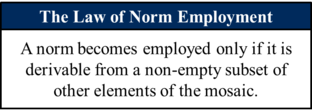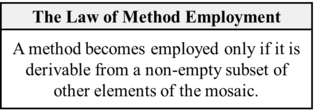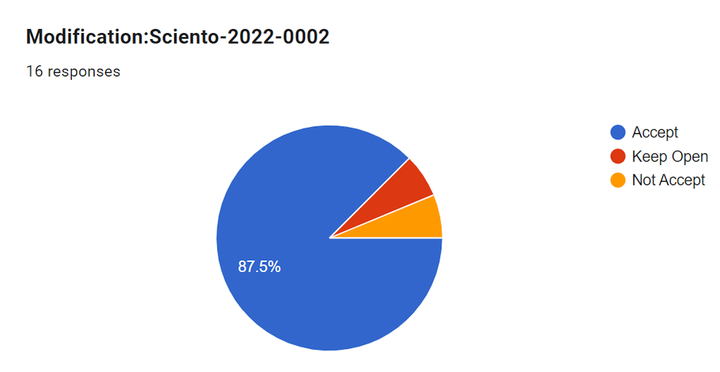Difference between revisions of "Modification:Sciento-2022-0002"
| Line 17: | Line 17: | ||
The new law of norm employment aims to remedy all three of these issues: | The new law of norm employment aims to remedy all three of these issues: | ||
* the formulation of the covers all norms rather than only methods; | * the formulation of the covers all norms rather than only methods; | ||
| − | * it replaces | + | * it replaces ''deducible'' with ''derivable'', which in the context of mathematical model theory simply means to ''be semantically entailed'', and thus can potentially include non-deductive inferences (e.g. inductive, abductive); |
* it replaces a specific enumeration of epistemic elements with a general "elements of the mosaic". | * it replaces a specific enumeration of epistemic elements with a general "elements of the mosaic". | ||
Revision as of 16:29, 30 October 2022
Accept the new law of norm employment that fixes some of the issues of the current law of method employment and makes it applicable to norms of all types.
The modification was suggested to Scientonomy community by William Rawleigh on 28 February 2022.1 The modification was accepted on 21 February 2024.
Contents
Preamble
At present, there are several problems with how the third law is formulated and operates that need to be resolved. Foremost among these is that the third law is, in its current form, based on an outdated ontology that assumes that methods of theory evaluation are a fundamental member of our ontology of epistemic elements. After the acceptance of Barseghyan’s proposal that methods be subsumed under the category of normative theories, the third law no longer exhaustively covers any situation in which we employ any kind of normative theory. In its present form it is limited to methods, though there is no strictly logical justification at present for thinking that the mechanism by which a method is employed is any different than the mechanism by which any other norm is employed.
In addition, the current formulation of the third law uses the term deducible, which currently lacks a scientonomic definition. We do not currently know what it means for something to be deducible, what the criteria of deducibility would be, or whether the conditions of deducibility would be part of the first-order theories of the mosaic or part of the second-order theories that range over the mosaic.
The third issue with the current formulation is that, with the acceptance of questions into the epistemic elements of the ontology of scientific change, the elements of the mosaic are now more expansive than just theories and subtypes of theories. This means that there is a plausible situation in which norms could potentially be derived – at least in part – from questions, which means that a formulation of the third law that excludes questions would fail to comprehensively describe all cases of norm employment.
The new law of norm employment aims to remedy all three of these issues:
- the formulation of the covers all norms rather than only methods;
- it replaces deducible with derivable, which in the context of mathematical model theory simply means to be semantically entailed, and thus can potentially include non-deductive inferences (e.g. inductive, abductive);
- it replaces a specific enumeration of epistemic elements with a general "elements of the mosaic".
This definition also offers the slight clarification that derivability strictly deals with derivation from a finite number of other elements.
A law of method employment can be deduced strictly from the law of norm employment.
Modification
Theories To Accept
- The Law of Norm Employment (Rawleigh-2022): A norm becomes employed only if it is derivable from a non-empty subset of other elements of the mosaic.
- The Law of Method Employment (Rawleigh-2022): A method becomes employed only if it is derivable from a non-empty subset of other elements of the mosaic.
Theories To Reject
- The Third Law (Sebastien-2016): A method becomes employed only when it is deducible from some subset of other employed methods and accepted theories of the time.
Questions Answered
This modification attempts to answer the following question(s):
- Mechanism of Method Employment: How do methods become employed by an epistemic agent?
- Mechanism of Norm Employment: How do norms become employed by an epistemic agent?
Verdict
The modification was accepted on 21 February 2024. Prior to the 2024 workshop, Hakob Barseghyan commented on the encyclopedia with his opinion that the modification should be accepted given that the formulation seemed relatively future-proof: it would not have to change even if more elements are included into our ontology. Paul Patton and Cameron Scott raised some concerns about the differences between norm employment and norm acceptance, and about the derivability of norms from agents’ mosaics, given cases in the history of science where agents accept a norm that is derivable from their mosaic but do not act accordingly (that is, they fail to employ the norm). However, it was noted that this is a separate issue from what the modification aims to do: the law of norm employment does not describe what happens to norms that are already present in the mosaic, but merely describes how norms come to be part of the mosaic. Yet, the discrepancy in the community’s accepted definitions of norm acceptance (as a subtype of theory acceptance) and norm employment was highlighted as a pertinent issue for later focus. After this clarification, there were no further issues raised, and the modification was accepted by over a two-thirds majority of voters. 14 out of 16 votes were for acceptance.
Click on the Discussion tab for comments.
References
- ^ Rawleigh, William. (2022) Reconceiving Scientific Mosaics: A New Formalization for Theoretical Scientonomy. In Barseghyan et al. (Eds.) (2022), 83-103.


